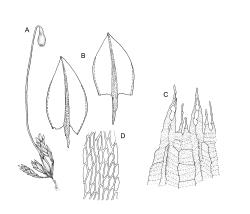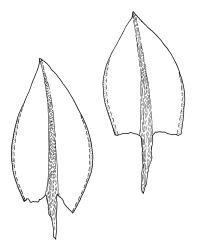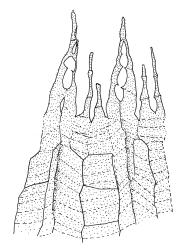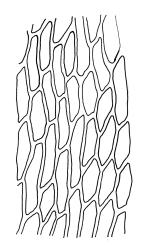- ≡ Ptychostomum pallescens (Schwägr.) J.R.Spence, Phytologia 87: 21 (2005)
- = Bryum thomasii R.Br.bis, Trans. & Proc. New Zealand Inst. 31: 447 (1899)
Plants brown- or yellow-green, forming rather thick cushions or turves. Stems red, to at least 15 mm, branching repeatedly by innovation, beset below with dark red- or chocolate-brown, papillose rhizoids, in cross-section with firm-walled cortical cells and a weak central strand. Leaves larger and crowded at stem apex, erect-spreading when moist, tightly erect and ± twisted around stem with dry, oblong-ovate, widest at or near mid leaf, acute or short-acuminate, 1.4–2.4 × c. 0.8 mm (some vegetative leaves shorter) and with lamina c. 0.9 the entire leaf length, concave, mostly red at base, entire or denticulate near apex, bordered (sometimes weakly) and recurved at margins, not decurrent; upper laminal cells hexagonal, firm-walled, 45–60 µm long and c. 3:1, not altered near apex, longer and more oblong in lower leaf; marginal cells linear and firm-walled to form a weak to moderate border c. 2–3 cells wide at mid leaf and extending ± to apex; basal cells pigmented but not otherwise differentiated. Costa red below, short- or long-excurrent (usually forming a short cusp). Brood bodies (including tubers) absent.
Synoicous. Perichaetia terminal (at the end of successive subperichaetial innovations). Setae c. 15–20 mm, cygneous just below capsule; capsules pendent, narrowly pyriform, constricted below the mouth when dry, (1.8–)2–2.5 mm long, with a well-defined neck c. ⅓ the total length and wrinkled when dry. Exostome teeth pale yellow-brown; endostome free of exostome, the segments with oval perforations and paired, nodose to weakly appendiculate cilia. Spores 21–24, papillose.
Crum & Anderson 1981, fig. 257, A–H; Smith 2004, fig. 183, 1–4; Ochyra et al. 2008, fig. 225.
The boundary between B. pallescens and B. creberrimum is not always clear in N.Z. Bryum pallescens appears to be distinguishable by the following features: shorter, more pyriform capsules; endostomal cilia mostly two and less appendiculate; and synoicous sexuality. Some intermediate material is discussed under B. creberrimum, q.v.
Confusion between B. pallescens and B. algovicum var. rutheanum is possible as both taxa are synoicous, have rather short pyriform capsules, and share some vegetative leaf characters. However, the free endostome and the more strongly developed cilia of B. pallescens normally preclude confusion with the latter taxon.
Bryum pallescens can be confused with Rosulabryum capillare, due to the spiralling of dry leaves around the stem and synoicy, but the former is distinguished by leaves that are oblong-ovate and widest near mid leaf (rather than ± spathulate), larger and more papillose spores, shorter capsules, less well-developed endostomal cilia, and an absence of rhizoidal tubers.
SI: Canterbury (Styx Marsh, Cave Stream, Rough Creek), Otago (Naseby, Cardrona).
Bipolar. Reported to be widespread in northern hemisphere (Smith 2004, p. 564). Ochyra et al. (2008) recorded it from the Antarctic Peninsula, Tierra del Fuego, Falkland Is, South Orkney Is, and South Sandwich Is. Spence & Ramsay (2013) recently recorded this species from Tasmania.
The habitat preferences of this species are rather poorly known in N.Z. Known from widely disparate elevations ranging from sea level (Styx Marsh) to 1632 m (Cardrona). A collection by P. Beveridge from Cardrona came from semi-shaded, thin soil on a "small vegetated schist block in tussock grassland" at 1632 m. Smith (2004) indicates this species sometimes occurs on heavy-metal mine waste in Britain.
The capsules illustrated by Smith (2004) and by Crum & Anderson (1981) are longer and more cylindric than those in N.Z. material of this species. The leaves illustrated by Ochyra et al. (2008) have longer and more excurrent costa than seen in N.Z. material.
Bryum pallescens and B. creberrimum s.l. (including what has been termed B. affine) share the characteristics of being monoicous (either autoicous or synoicous), with generally large spores, ovate-lanceolate, ± entire leaves that are weakly to strongly spiralled when dry, and firm-walled, non-porose laminal cells. Monoicy (variously expressed in the two species) is also relatively uncommon among N.Z. species and hence a useful recognition feature.
Bryum austro-pallescens Broth. is here considered as a synonym of B. creberrimum, in contrast to Ochi's (1970, p. 37) referral of it to B. pallescens. Ochi (1984) tentatively placed B. thomasii in synonymy with B. pallescens. Brown's immature type has been examined and its observable features (including synoicous sexuality) are consistent with Ochi's conclusion.








